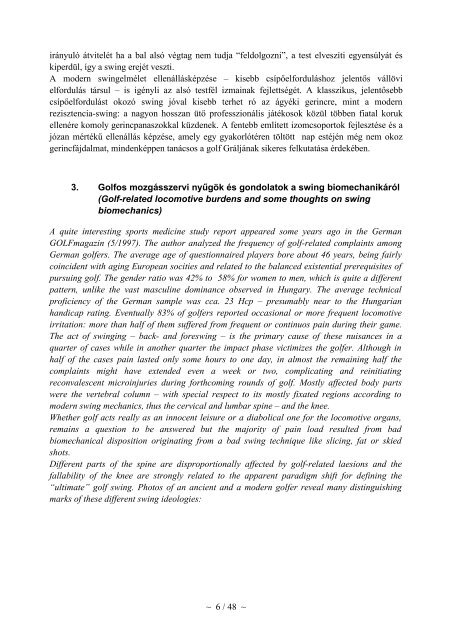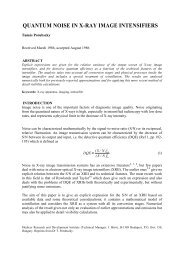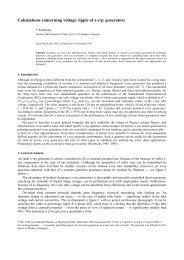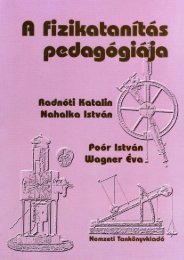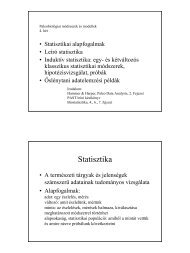A Hungarian Golf (korábban: Hole In One) elit életmód-magazin
A Hungarian Golf (korábban: Hole In One) elit életmód-magazin
A Hungarian Golf (korábban: Hole In One) elit életmód-magazin
Create successful ePaper yourself
Turn your PDF publications into a flip-book with our unique Google optimized e-Paper software.
irányuló átvitelét ha a bal alsó végtag nem tudja “feldolgozni”, a test elveszíti egyensúlyát és<br />
kiperdül, így a swing erejét veszti.<br />
A modern swingelmélet ellenállásképzése – kisebb csípőelforduláshoz jelentős vállövi<br />
elfordulás társul – is igényli az alsó testfél izmainak fejlettségét. A klasszikus, jelentősebb<br />
csípőelfordulást okozó swing jóval kisebb terhet ró az ágyéki gerincre, mint a modern<br />
rezisztencia-swing: a nagyon hosszan ütő professzionális játékosok közül többen fiatal koruk<br />
ellenére komoly gerincpanaszokkal küzdenek. A fentebb említett izomcsoportok fejlesztése és a<br />
józan mértékű ellenállás képzése, amely egy gyakorlótéren töltött nap estéjén még nem okoz<br />
gerincfájdalmat, mindenképpen tanácsos a golf Gráljának sikeres felkutatása érdekében.<br />
3. <strong>Golf</strong>os mozgásszervi nyűgök és gondolatok a swing biomechanikáról<br />
(<strong>Golf</strong>-related locomotive burdens and some thoughts on swing<br />
biomechanics)<br />
A quite interesting sports medicine study report appeared some years ago in the German<br />
GOLF<strong>magazin</strong> (5/1997). The author analyzed the frequency of golf-related complaints among<br />
German golfers. The average age of questionnaired players bore about 46 years, being fairly<br />
coincident with aging European socities and related to the balanced existential prerequisites of<br />
pursuing golf. The gender ratio was 42% to 58% for women to men, which is quite a different<br />
pattern, unlike the vast masculine dominance observed in Hungary. The average technical<br />
proficiency of the German sample was cca. 23 Hcp – presumably near to the <strong>Hungarian</strong><br />
handicap rating. Eventually 83% of golfers reported occasional or more frequent locomotive<br />
irritation: more than half of them suffered from frequent or continuos pain during their game.<br />
The act of swinging – back- and foreswing – is the primary cause of these nuisances in a<br />
quarter of cases while in another quarter the impact phase victimizes the golfer. Although in<br />
half of the cases pain lasted only some hours to one day, in almost the remaining half the<br />
complaints might have extended even a week or two, complicating and reinitiating<br />
reconvalescent microinjuries during forthcoming rounds of golf. Mostly affected body parts<br />
were the vertebral column – with special respect to its mostly fixated regions according to<br />
modern swing mechanics, thus the cervical and lumbar spine – and the knee.<br />
Whether golf acts really as an innocent leisure or a diabolical one for the locomotive organs,<br />
remains a question to be answered but the majority of pain load resulted from bad<br />
biomechanical disposition originating from a bad swing technique like slicing, fat or skied<br />
shots.<br />
Different parts of the spine are disproportionally affected by golf-related laesions and the<br />
fallability of the knee are strongly related to the apparent paradigm shift for defining the<br />
“ultimate” golf swing. Photos of an ancient and a modern golfer reveal many distinguishing<br />
marks of these different swing ideologies:<br />
~ 6 / 48 ~


